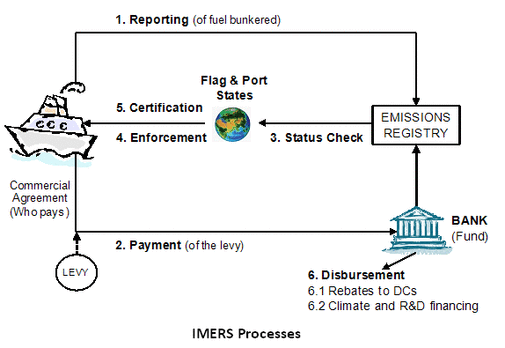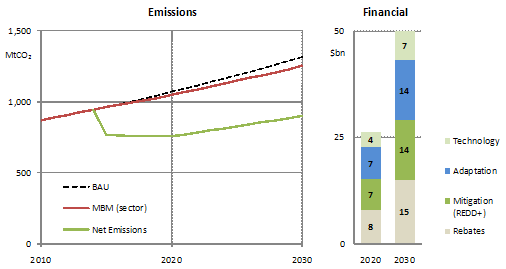IMERS (RM integrated)
This section describes the third generation of IMERS (also known as RM integrated, see Rebate Mechanism and MEPC 61).
IMERS in 30 words
A levy on fuel for international shipping with a rebate mechanism for developing countries. Applied worldwide, collected centrally - bypassing national coffers - raising US$10bn+ annually for climate change action.
Details
Under the proposed scheme a market-based levy is established on fuel bunkered (fuel delivered to a ship), as an alternative for a levy on CO2 emissions. The levy would apply to all ships over a predetermined size, engaged in international maritime transport, irrespective of their flag and nationality of the ship-owner. The liable entity in the scheme is a ship, uniquely identified by its IMO number.
Fuel bunkered in a given quarter must be electronically reported and is subject to payment of the constant levy for that quarter. The levy is obtained centrally, bypassing national coffers, and aggregated providing gross revenue for the scheme.
In order to deliver proportionality of the shipping effort to combating climate change, the levy is linked to a prevailing fee on land transport emissions, or to the rolling average market carbon price, as available. To increase price predictability the levy is set constant for a quarter, at least 30 days in advance of the start of each quarter. Thus the shipping industry would pay the most cost-effective price for its emissions and a fair one, in a simple manner.
In order to increase investment certainty, the levy is bounded by a predetermined price floor and ceiling, established for many years. These may be already defined implicitly through the price floor and ceiling of the carbon price the levy is linked to.
In order to maximize cost-efficiency, reduce the burden on the shipping industry, and guarantee a rapid deployment globally, a computer-based system and simple processes are defined.
The system is based on a central emissions registry (ER), holding an emission account for each ship, and a predetermined global bank (BK), or banks, providing a payment account for each ship, as shown in Fig. 2. The scheme operates through six processes (shown on Figure below):
- reporting of fuel bunkered, by ship (manager) to ER;
- payment of the levy, by ship (charterer) to BK, directly;
- status check of ship's compliance, by port and flag State control (PSC and FSC) with ER;
- enforcement of compliance, by PSC and FSC;
- certification of ship compliance, by FSC; and
- disbursement of revenue raised by BK and/or predetermined funds.

In order to comply with the UNFCCC principles and provisions, the rebate mechanism as introduced above applies, and is the first step of the disbursement process (6).
In summary, every developing country is entitled to obtain an unconditional payment (rebate). The rebate is calculated annually in proportion to a country’s share of global seaborne imports (attribution key) and the gross revenue raised. A developing country could voluntarily decide to forego the rebate, or a part of it, and record its decision.
More details
Scheme effectiveness, as well as how the scheme secure advantages to shipping and world trade are described below (follow the relevant navigation links).
Scheme Effectiveness
The net revenue raised by the scheme, after the rebates have been issued, is split between assisting developing countries in implementing climate change action, and assisting the global shipping sector in accelerating reductions of its growing emissions through technological advances.
Consequently, the net revenue would come from consumers in developed countries only, complying with the principles of the UNFCCC. Furthermore, developing countries would be beneficiaries of such a scheme, with the most vulnerable countries to benefit most through the relevant rules and provisions applied to the disbursement of net revenue. The shipping sector should also benefit from the net revenue, potentially through a new global Maritime Technology Fund, or similar.
In order to maximize environmental effectiveness and cost-efficiency, the entire net revenue raised is to be disbursed through existing institutions for: (a) Adaptation to climate change in developing countries, (b) Mitigation programs, such as reduction of emissions from deforestation and forest degradation (REDD+), and (c) Technology R&D, transfer, and transformation to low carbon shipping.
Although not discussed in detail, it is proposed to reserve a significant pool of adaptation funding to the most vulnerable Small Island Developing States (SIDS), Least Developed Countries (LDCs) and Africa.
To illustrate the benefits and costs of such proposal, we model an average scenario for shipping emission growth, and assume carbon price scenario, as summarized in Table below (identical to the medium carbon price scenario used in IMO 2010c).
|
Parameter |
Value |
|
Annual emission growth, 2010-2030 |
2.1% |
|
Emissions in 2010; as in 2007 (MtCO2) |
870 |
|
Scheme launch date |
2015 |
|
Carbon price in: 2015; 2020; 2030 (US$/tCO2) |
22.5; 25; 40 |
|
Phase-in period (from 75% to 100% levy) |
5 years |
We assume that circa 30% of gross revenue would be spent on rebates for developing countries. We further assume that the net revenue, the remaining 70% of gross revenue, is spent on climate change mitigation, adaptation, and technology, balancing different needs. How the net revenue is allocated would be a decision by Parties. For modelling purposes we use illustrative financing assumptions as shown in Table below.
|
Rebates |
For developing countries, those that have not foregone the rebate. Used according to their sovereign decisions. May be used for national climate change fund, or similar. |
|||||||||
|
Net Revenue (70% of gross revenue) |
|
The modelled emissions and financial details are shown below.

The left graph shows three types of emissions: BAU (business as usual), MBM (sector), and Net emissions (in MtCO2). The right graph illustrates the financial details for the four target spent areas: rebates, mitigation (REDD+), adaptation, and technology for 2020 and 2030 (in US$ billions)
BAU refers to emissions without applying MBM. It already incorporates any reductions achieved through technical and operational measures. MBM (sector) refers to emissions after applying the MBM. Net Emissions shows the effect of mitigating shipping emissions from REDD+ arrangements, and similar. This line in the period 2015-2020 is nearly horizontal due to the phase-in of the scheme over the period of 5 years. From 2020, it generally follows the trend of MBM (sector) equivalent to 72% of the total, given that 28% of shipping emissions are mitigated (from the 40% of net revenue spent on mitigation).
It is anticipated that the significant technology financing proposed, for R&D and similar, would reduce shipping emissions in later years. However such benefits are not reflected in the modelling. Potential capture and sequestration of CO2 emissions are also not included.
The total cost burden of the scheme, ignoring any benefits, are circa US$26 billions in 2020 and US$50 billions in 2030, as shown in Financial figure. However, these numbers are very small when compared with the value of seaborne trade measured in US$ trillions.
We estimate the maximum potential increase in the total value of seaborne trade, due to the above cost burden, to be under 0.2% in 2020, as shown in Table below. It could be argued that at this level, the potential impact (cost impost) of the MBM on the value of seaborne trade is marginal.
|
Emissions |
Cost |
Seaborne Trade |
Cost/Seaborne Trade |
|
1,050 |
26.3 |
15.5 |
0.17 |
In conclusion, owing to the high energy efficiency of seaborne transport, the scheme would be easily affordable. Assuming that all costs are passed on to the end customers, the potential impact on them would be very small at circa 0.2% increase in final price of imported goods (this is equivalent to only $2 for every $1,000 value of imported goods). Yet, the scheme would bring significant environmental benefits as calculated above, as well as various supplemental benefits.
Securing Advantages to Shipping and World Trade
The shipping industry demands that a maritime MBM should be proportional to similar measures taken in other industries, including other modes of transport. One approach to delivery proportionality would be to ensure that shipping is subject to the same carbon price as other industries, on average. This could be achieved by linking the maritime MBM to an economy-wide reduction scheme or schemes. The additional benefit of such price linkage would be that a global emission reduction target for international shipping (cap) would not be required, eliminating the contentious issue of setting such a cap.
Providing that shipping is subject to the same carbon price as other sectors, the negative impact on the volume of seaborne trade would be marginal, if any (before any improvements are considered). Even though shipping is the most cost and energy efficient mode of transport, it has a significant potential to increase its energy efficiency further (IMO 2009). Furthermore, the greatest scope for efficiency improvements is in the supply chain to and from developing countries, including trade facilitation. Due to incentives from the MBM, and additional investments, the cost of transport for developing countries would be reduced most, contributing positively to their increased trade and development.
To further increase benefits to the most vulnerable developing countries, including the Small Island Developing States (SIDS), the application threshold for an MBM could be set at a level higher than 400 gross tonnage (GT), for instance at 4,000 GT, at least initially. This would practically exclude the majority of all ships serving the remote SIDS, as their ports typically can receive only smaller ships (Faber and Rensma 2008).
Increasing the application threshold from for instance 400GT to 4,000GT would accelerate the MBM implementation, by significantly reducing the number of ships subject to the instrument without necessarily having a major effect on emissions – it is estimated that the total emission coverage would only reduce by 9%. Therefore, the initial coverage of emissions from international shipping would remain relatively high at 91%, when compared with the emissions coverage for ships of 400 GT and above. The number of ships subject to MBM would be nearly halved in this initial period, given that the total number of ships over 400 GT and 4,000GT in 2010 was approximately 43 and 24 thousand, respectively (for other thresholds see IMO 2010c).